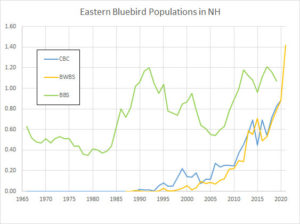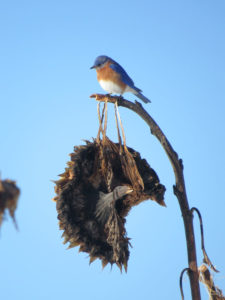(Photos and story by Pam Hunt)
There was a time not too long ago when bluebirds would have been considered an unusual choice for a winter bird column, and New Hampshire Audubon still gets calls from people who are worried that their bluebirds haven’t migrated south in the fall. There is no need to worry, since bluebirds, like American Robins, are now a regular winter bird here in the Granite State. It wasn’t always this way, of course, and therein lies the premise for this month’s bit of ornithological storytelling.

Back in the early and mid-1900s, bluebirds had declined due to competition with starlings and House Sparrows, both of which will aggressively exclude other birds from nesting cavities. The widespread introduction of bluebird boxes has reversed that trend, and today bluebirds are a common sight along New Hampshire’s roads and fields. This is shown quite clearly in the green line on Figure 1, which represents the state’s breeding populations. And while I’ve usually got an explanation for most ups and downs in bird populations, the decline from 1990 to 2005 is completely mystifying to me. There is evidence that bluebirds are susceptible to cold temperatures, which in fact were behind regional declines in the 1970s, but since then the Northeast has been seeing warmer and warmer winters. Whatever the reason, bluebirds were back on the rise after 2005.
The previous paragraph was all about our breeding bluebirds, but as alluded to at the start of this column there is something even more amazing happening in the winter. Data from both the Christmas Bird Count (CBC) and Backyard Winter Bird Survey (BWBS) show increases starting around 1995 and accelerating in the early 2000s. On the BWBS, bluebirds have even outnumbered American Robins in the last few years, and if observations in December 2021 are any indication this pattern is likely to continue. At present, almost all winter bluebirds are south of the White Mountains, but this was similarly true of robins 10-15 years ago, and that species is becoming more prevalent in Coos County.

If you want to increase your chances of seeing bluebirds in your yard in winter, consider providing them with food such as dried mealworms (many are actually the larvae of Black Soldier Flies) and suet. They will also readily spend winter nights roosting communally in bird houses or natural cavities. To help us track New Hampshire’s winter bluebird populations, we encourage you to participate in the annual Backyard Winter Bird Survey each February.
State of the Birds at a Glance:
- Habitat: Grasslands and Developed
- Migration: Short-distance
- Population trend: strongly increasing, especially in winter
- Threats: cats, collisions, and other risks in developed landscapes; insecticides and other contaminants
- Conservation actions: Keep cats indoors, provide nest boxes, avoid toxic chemicals on lawns and gardens
NH Audubon’s “Backyard Winter Bird Survey” will occur on February 12-13, 2022. Visit https://www.nhaudubon.org/education/birds-and-birding/backyard-winter-bird-survey/ for details.
More information on “The State of New Hampshire’s Birds” is available at: https://www.nhaudubon.org/conservation/the-state-of-the-birds/
